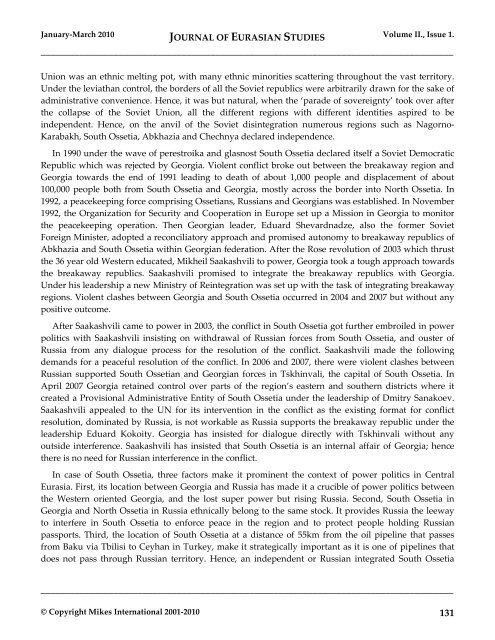EurasianStudies_0110..
EurasianStudies_0110..
EurasianStudies_0110..
Create successful ePaper yourself
Turn your PDF publications into a flip-book with our unique Google optimized e-Paper software.
January-March 2010 JOURNAL OF EURASIAN STUDIES Volume II., Issue 1.<br />
_____________________________________________________________________________________<br />
Union was an ethnic melting pot, with many ethnic minorities scattering throughout the vast territory.<br />
Under the leviathan control, the borders of all the Soviet republics were arbitrarily drawn for the sake of<br />
administrative convenience. Hence, it was but natural, when the ‘parade of sovereignty’ took over after<br />
the collapse of the Soviet Union, all the different regions with different identities aspired to be<br />
independent. Hence, on the anvil of the Soviet disintegration numerous regions such as Nagorno-<br />
Karabakh, South Ossetia, Abkhazia and Chechnya declared independence.<br />
In 1990 under the wave of perestroika and glasnost South Ossetia declared itself a Soviet Democratic<br />
Republic which was rejected by Georgia. Violent conflict broke out between the breakaway region and<br />
Georgia towards the end of 1991 leading to death of about 1,000 people and displacement of about<br />
100,000 people both from South Ossetia and Georgia, mostly across the border into North Ossetia. In<br />
1992, a peacekeeping force comprising Ossetians, Russians and Georgians was established. In November<br />
1992, the Organization for Security and Cooperation in Europe set up a Mission in Georgia to monitor<br />
the peacekeeping operation. Then Georgian leader, Eduard Shevardnadze, also the former Soviet<br />
Foreign Minister, adopted a reconciliatory approach and promised autonomy to breakaway republics of<br />
Abkhazia and South Ossetia within Georgian federation. After the Rose revolution of 2003 which thrust<br />
the 36 year old Western educated, Mikheil Saakashvili to power, Georgia took a tough approach towards<br />
the breakaway republics. Saakashvili promised to integrate the breakaway republics with Georgia.<br />
Under his leadership a new Ministry of Reintegration was set up with the task of integrating breakaway<br />
regions. Violent clashes between Georgia and South Ossetia occurred in 2004 and 2007 but without any<br />
positive outcome.<br />
After Saakashvili came to power in 2003, the conflict in South Ossetia got further embroiled in power<br />
politics with Saakashvili insisting on withdrawal of Russian forces from South Ossetia, and ouster of<br />
Russia from any dialogue process for the resolution of the conflict. Saakashvili made the following<br />
demands for a peaceful resolution of the conflict. In 2006 and 2007, there were violent clashes between<br />
Russian supported South Ossetian and Georgian forces in Tskhinvali, the capital of South Ossetia. In<br />
April 2007 Georgia retained control over parts of the region’s eastern and southern districts where it<br />
created a Provisional Administrative Entity of South Ossetia under the leadership of Dmitry Sanakoev.<br />
Saakashvili appealed to the UN for its intervention in the conflict as the existing format for conflict<br />
resolution, dominated by Russia, is not workable as Russia supports the breakaway republic under the<br />
leadership Eduard Kokoity. Georgia has insisted for dialogue directly with Tskhinvali without any<br />
outside interference. Saakashvili has insisted that South Ossetia is an internal affair of Georgia; hence<br />
there is no need for Russian interference in the conflict.<br />
In case of South Ossetia, three factors make it prominent the context of power politics in Central<br />
Eurasia. First, its location between Georgia and Russia has made it a crucible of power politics between<br />
the Western oriented Georgia, and the lost super power but rising Russia. Second, South Ossetia in<br />
Georgia and North Ossetia in Russia ethnically belong to the same stock. It provides Russia the leeway<br />
to interfere in South Ossetia to enforce peace in the region and to protect people holding Russian<br />
passports. Third, the location of South Ossetia at a distance of 55km from the oil pipeline that passes<br />
from Baku via Tbilisi to Ceyhan in Turkey, make it strategically important as it is one of pipelines that<br />
does not pass through Russian territory. Hence, an independent or Russian integrated South Ossetia<br />
_____________________________________________________________________________________<br />
© Copyright Mikes International 2001-2010 131

















